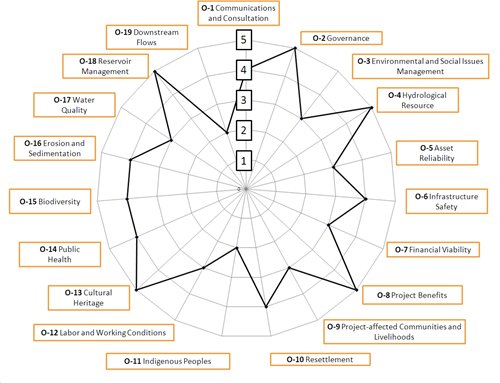Greenwashing Dams Factsheet

A dam industry effort threatens to greenwash dams and undermine the recommendations of the World Commission on Dams (WCD). The Hydropower Sustainability Assessment Protocol (HSAP) is a voluntary, non-binding auditing tool that allows dam builders to score the sustainability of their own dam projects. This civil society fact sheet examines how the HSAP works, its shortcomings, and why it could end up legitimizing destructive dams.
The HSAP was created between 2007 and 2010 by the Hydropower Sustainability Assessment Forum (HSAF), an initiative of the International Hydropower Association (IHA), a lobbying group formed in 1995 to represent the interests of dam builders. Participation in the HSAF was limited to a self-selected group of industry representatives, government agencies, financiers, and large non-governmental organizations (NGOs). Meanwhile, civil society organizations from the Global South and dam-affected people were excluded.
HSAP “Sustainability Partners” include thirteen of the world’s most controversial dam builders. Check the list (as of May 2013) here.
The HSAP is Not a Standard
The HSAP is not a precautionary measure, a standard, or a safeguard. Instead, it is a voluntary auditing tool that scores individual dams on 19-23 categories related to dam-building. These include Communication and Consultation; Governance; Environmental and Social Management; Infrastructure Safety; Project Benefits; Project Affected Communities and Livelihood; Resettlement; Indigenous Peoples; and others. There are four types of HSAP assessment, one for each phase of dam building: Early Stage, Preparation Stage, Implementation Stage, and Operation Stage.
The HSAP has no basis in international convenants, declarations, or laws. The HSAP does not require compliance with national laws as a condition of sustainability; there is only a stated expectation that developers will do so. In areas such as human rights, gender impact, and cumulative impact assessment, the Protocol falls short of existing best practice.
A Lack of Transparency
Meanwhile, the HSAP is based on poor transparency, access to information, and participation of affected communities in project assessments. The dam industry controls the accreditation and selection of assessors, and the terms of the assessment. Assessors can meet with as few as one community, which limits efforts for engagement There are no methods for civil society to act as assessment observers, and an assessment’s evidence is frequently not made public. As a result, there is great risk that the majority of information collected in HSAP assessments will originate from the dam builder itself. Without an independent oversight committee to guarantee broad participation and truly objective information, HSAP assessments could allow the dam industry to greenwash a dam as “sustainable” while rights violations and poor practices get swept under the rug. To read and endorse our full critique of the shortcomings of the HSAP, please visit here.
A Subjective Scoring System
The HSAP scoring system itself is biased to the benefit of dam builders. There are three baseline scores: 1, 3, and 5. Yet, scoring follows a twisted logic: dams automatically receive a score of 3 to begin with, and points are only subtracted if evidence shows otherwise. Assuming a project will meet “basic good practice” provides an easy opportunity to greenwash the dam. If no points are subtracted, a dam auomatically receives a score of 5, and points are subtracted again if necessary. Dam builders are never required to make improvements if they obtain scores lower than 3.
A score of 1 represents “significant gaps relative to basic good practice.” |
A Certification System to Greenwash Dams
Despite HSAP’s lack of requirements and non-binding nature, the IHA has stated on various occasions that it eventually aims to develop the Protocol into an “industry-wide, global standard.” IHA may try to obtain approval from ISEAL, a voluntary certification body, to create a certification system to market the brand “sustainable hydropower,” much like the Forest Stewardship Council created a certification system to brand the term “sustainable forests and forest products.”
The risk is that such a certification system could brand any dam that has undergone an HSAP assessment as a “sustainable dam,” regardless of the assessment’s scores, the legitimacy of its evidence, or cconcerns from civil society.
As of 2013, the HSAP governance council had yet to agree on methodologies for such a certification system. Still, given the profound impacts that dams cause, the creation of a sustainable dam certification system that is controlled and designed by the dam industry.
What You Can Do:
The HSAP threatens to greenwash dams; not improve the social and environmental responsibilities of the dam industry. You can do your part to prevent this from happening. A few ideas include:
Tell your government and banks to support the WCD:
Tell your national government and dam financiers to endorse the Recommendations of the World Commission on Dams, not the HSAP. Urge your government to adopt stronger benchmarks for dams that truly address the needs, livelihoods, and rights of dam-affected communities and the environment.
Monitor and engage with HSAP assessments:
Any hydropower project in your country may be subject to an HSAP assessment. Monitor dam builders’ commitments to HSAP and their HSAP assessments. Contact the project developer and assessor, demand to participate in and observe project assessments, and monitor their status.
Submit public comments on official HSAP assessments:
Each HSAP “Sustainability Partner” must publish any official assessment using the Protocol on www.hydrosustainability.org for a 60-day period of public comment. Use our guide (linked below) to structure your comments.
Let us know what you hear:
Tell us if there is an HSAP assessment occurring or rumored to occur on a dam in your country, what’s wrong with it, and what you’d like to do.
- Check the List of HSAP “Sustainability Partners”
- Download our Guide “Fight Back Against Greenwash” to learn how to engage and submit comments on HSAP assessments
- Contact your national media to condemn dam builders and financiers for greenwashing dams
- Read and Endorse our Critique of the HSAP
- Learn More about the World Commission on Dams




